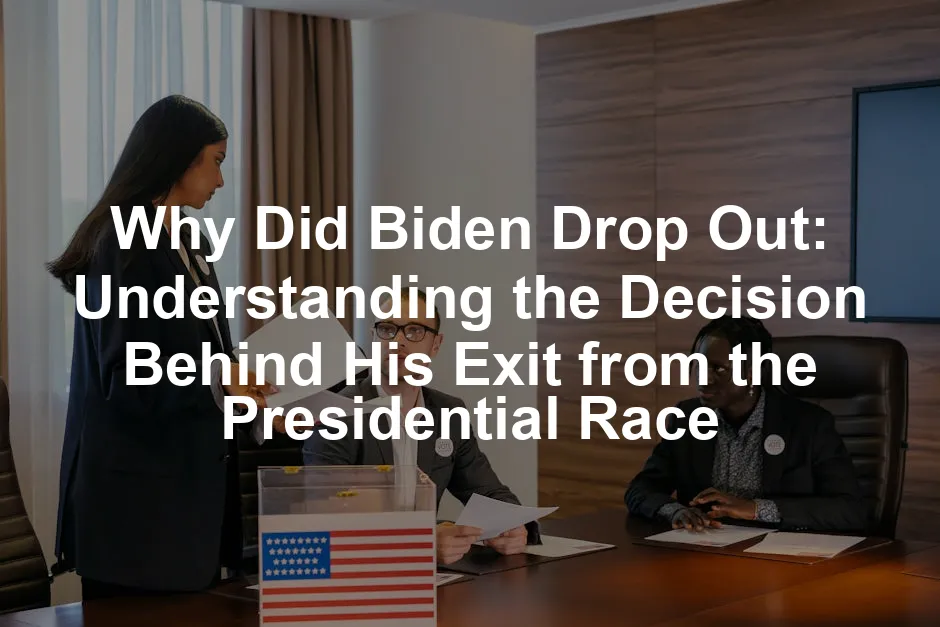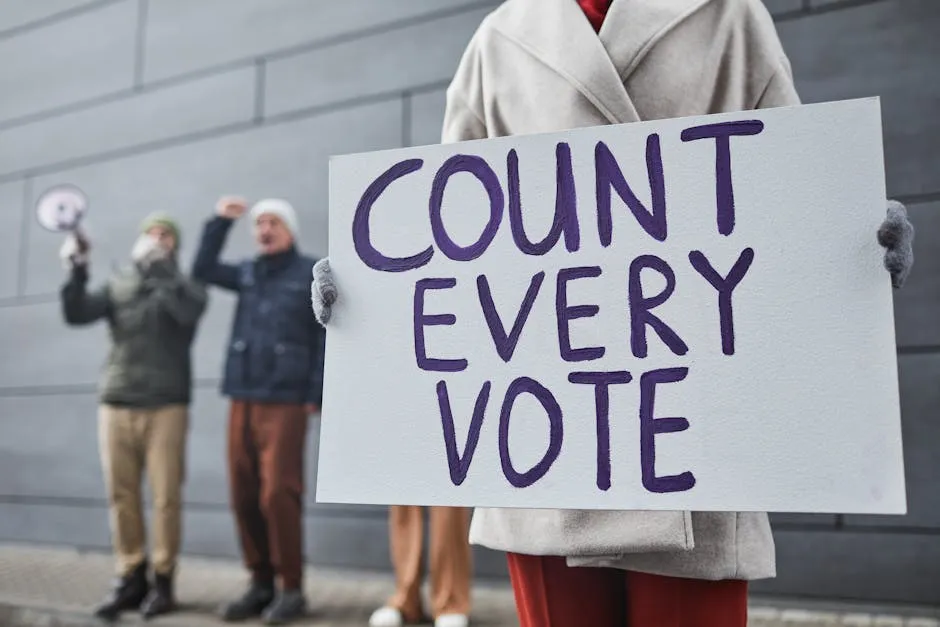
Why Did Biden Drop Out: Understanding the Decision Behind His Exit from the Presidential Race
Summary and Overview
In a surprising turn of events, President Joe Biden announced his withdrawal from the presidential race on July 21, 2024. This marked a historic moment, as he became the first sitting president to drop out of a re-election campaign in over fifty years. The decision came after intense pressure from Democratic leaders and public concerns about his age and fitness for office.
Biden’s endorsement of Vice President Kamala Harris as his successor highlighted his commitment to party unity. Polling data revealed that many Democrats felt his continued candidacy could jeopardize their chances in upcoming elections. Public sentiment shifted rapidly following a poor debate performance against Donald Trump, which raised doubts about Biden’s viability as a candidate. As the Democratic Party seeks to regroup, this pivotal moment will undoubtedly shape the future of U.S. politics and the party’s strategy moving forward.

For those looking to dive deeper into the political landscape, consider reading Joe Biden: The Life, the Run, and the Future by Allen Salkin. This insightful book provides an in-depth look at Biden’s journey and the factors influencing his decision-making.
Biden’s Decision-Making Process
Influential Conversations and Key Figures
In the weeks leading up to Biden’s withdrawal, intense discussions took place among key Democratic leaders. Advisors and senior party figures urged him to reconsider his candidacy. The pressure grew notably after Biden’s poor debate performance against Donald Trump on June 27, which raised serious concerns about his age and capability to serve effectively.
Nancy Pelosi played a significant role in these conversations. She openly expressed doubts about the feasibility of Biden’s campaign, emphasizing the potential risks to Democrats in the upcoming elections. Pelosi’s influence was crucial; her concerns reflected a broader sentiment among party members. Many believed that Biden’s continued candidacy posed a threat to their electoral success.
Biden’s emotional state during this period was complex. He grappled with the realization that remaining in the race could divide the party. Reflecting on his legacy, Biden mentioned his desire to serve as a bridge to a new generation of leaders. Ultimately, he decided that stepping aside was in the best interest of both his party and the nation. This decision marked a pivotal moment in his long political career, highlighting the weight of his responsibilities as a leader.

Speaking of legacies, if you’re interested in the lessons of leadership and strategy, you might enjoy The Art of War by Sun Tzu. This classic text on strategy can provide valuable insights into navigating complex situations, much like Biden’s current predicament.
The Turning Point: The Debate Performance
Impact of the June 27 Debate
Biden’s performance during the June 27 debate against Trump raised eyebrows. Many felt he struggled to articulate his points clearly. This led to concerns about his mental acuity, especially at age 81. Key moments included Biden mixing up facts and losing his train of thought. His inability to counter Trump’s accusations effectively left voters and party members uneasy.
Reactions from within the Democratic Party were swift. Prominent figures, including Nancy Pelosi, expressed their worries about Biden’s viability. Discussions behind closed doors became heated, with many urging him to reconsider his campaign. They feared that a poor showing could hinder their chances in the upcoming elections.
Media coverage played a significant role in shaping public perception. Headlines highlighted Biden’s gaffes and questioned his fitness for office. Polls indicated a sharp drop in support following the debate, with many voters feeling uncertain about his ability to lead. This created a narrative that the party needed to act swiftly to ensure a stronger candidate could step in. The debate marked a critical turning point in Biden’s campaign, leading to his eventual decision to withdraw.

If you’re curious about the power dynamics in political campaigns, Political Campaigns: Media and Marketing in a Digital Age by John M. McCarthy delves into the strategies that shape modern political landscapes, a fitting read for anyone interested in the mechanics behind Biden’s decision.
Support for Kamala Harris
Transition of Power to Harris
After Biden’s withdrawal, he quickly endorsed Kamala Harris as his successor. This endorsement was pivotal, signaling a clear direction for the Democratic Party. Harris, who served as vice president under Biden, is well-equipped for this role. She has a strong political background, previously serving as a U.S. Senator from California and as Attorney General of the state.
Initial reactions from Harris and other Democratic leaders were supportive. Many saw this as an opportunity to unify the party and rally behind a candidate with experience. However, Harris faces challenges as the new frontrunner. Her approval ratings are low, hovering around 32%. This creates pressure to connect with voters and solidify her position as the Democratic candidate.

The party’s support for Harris is crucial. Many influential figures have rallied behind her, including the Congressional Black Caucus and prominent governors. Yet, her path to securing the nomination will require overcoming significant hurdles. The upcoming Democratic National Convention will be a critical moment for Harris as she seeks to consolidate support and present a strong front against Donald Trump.
To better understand the struggles of women in politics, check out The Woman’s Hour: The Great Fight to Win the Vote by Elaine Weiss. This book highlights the historical struggles women faced in securing their political rights, resonating deeply with Harris’s current situation.
Political Landscape After Biden’s Exit
Biden’s exit from the race reshapes the Democratic Party’s strategy heading into the election. Party leaders must quickly adapt to this new reality, focusing on unifying around Harris. This shift in strategy could attract younger voters who may be more energized by a new candidate.
The dynamics of the Democratic National Convention are now in flux. Harris is positioned as the frontrunner, but other candidates may still emerge, complicating the nomination process. The party needs to maintain unity to avoid a fragmented approach that could weaken their chances in the general election.
Fundraising efforts will also be affected. With Biden’s withdrawal, the party’s financial strategies must realign. They will need to focus on rallying support and contributions for Harris to ensure she can compete effectively against Trump. Party unity and a clear strategy will be essential as they navigate the uncertain waters leading up to the election.

If you’re interested in exploring the themes of power and strategy, consider reading The 48 Laws of Power by Robert Greene. This book offers timeless strategies that can be insightful in understanding the political landscape.
Conclusion
Biden’s decision to withdraw from the presidential race reshapes the political landscape. His exit underscores the pressures within the Democratic Party and highlights the need for unity. This pivotal moment emphasizes the importance of supporting Kamala Harris as she steps into the spotlight.
As the Democratic Party adjusts to this new reality, the focus shifts to upcoming elections. Harris’s candidacy offers a fresh direction, appealing to younger voters eager for change. With her at the helm, the party aims to strengthen its position against Donald Trump and rally support across diverse demographics.
The implications of Biden’s departure will echo in future elections, shaping both party strategy and candidate dynamics. As we move forward, the Democratic Party’s ability to unify around Harris will be crucial for their success in the 2024 elections.
The dynamics of the political landscape are constantly shifting, especially with key figures like Trump influencing the narrative. Understanding why Trump picked JD Vance as his running mate can provide insights into these changes.
Please let us know what you think about our content by leaving a comment down below!
Thank you for reading till here 🙂
All images from Pexels




